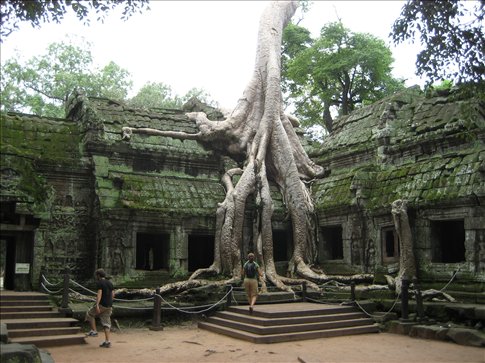Tour du Angkor
CAMBODIA | Friday, 17 July 2009 | Views [570]

Ta Phrom
In our effort to see as much of Angkor as possible in three days, we hopped on bikes and, like Lance, pedaled hard through the wind, rain, sun, and hordes of small children. Angkor is actually the name of a huge complex of temples (over 50) spread out over miles and miles and built at different times (but generally in and around 900-1200 AD). We began our tour with Angkor Wat, where we were trapped by a torrential rain storm that knocked down a full-size palm tree while we were watching. Luckily every outer wall of Angkor Wat is covered by detailed bas reliefs that depict mythological battles, Hindu gods, and the king who built Angkor Wat with his generals. The Indian influence is evident throughout Angkor, where Hinduism and Buddhism intermingle in carvings on every temple. After Angkor Wat, we proceeded to Angkor Thom which contains Bayon, possibly the most interesting temple if we had to pick one. Every spire has 4 faces on it, one on each side, so the entire building is covered with over 50 identical faces, all with a creepy, knowing smile. We rounded out day one of our tour with quick stops at the rest of Angkor Thom including climbing to top of a pyramid shaped temple that looks rather like Mesoamerican pyramids. The steps on all these temples are incredibly shallow making climbing a four-limbed endeavor. When you look down from the top, you begin to question your sanity in climbing up to begin with.
Day 2 of our Tour du Angkor was a 25 mile tour du force in which we visited 9 temples, not including ones we just biked by but didn't actually dismount to see (out of sheer exhaustion -- we had rusty old single speed bikes). The highlight of the day was probably Ta Phrom which is the only temple intentionally left unrestored so you can see what the temples looked like when the French originally "discovered" them. This is the classic Angkor temple with trees growing out of it and stones covered in moss and lying strewn across the grounds. The temples are all covered in intricate carvings. You can't tell from distant photos, but the lintels, pediments, moldings, walls -- nearly every surface -- is covered in bas reliefs, Sanskrit inscriptions, and other decorations.
On day 3 we put aside the bikes for power and performance: we hired a tuk-tuk. We saw Banteay Srei and Banteay Samre which are further afield (over 25 km away from Angkor Wat) and have lots of well-preserved carvings. Along the way we stopped at the Landmine Museum which describes the devastation inflicted by landmines in Cambodia and how landmines are removed and deactivated. People really do search for landmines by hand, probing the ground very carefully with sharp sticks. The museum also acts as a school and home for as well as a moving tribute to children injured by landmines.
And so concludes our time in Siem Reap. We are templed out, we love amok (a Khmer coconut curry dish), we took a cooking class and learned to cook amok, spring rolls, and banana flower salad, we conducted a conversation with three guys on a motorcycle while biking, we love Cambodians' friendliness, and now we're off to Phnom Penh.

Favourites
Photo Galleries
My trip journals
Travel Answers about Cambodia
Do you have a travel question? Ask other World Nomads.